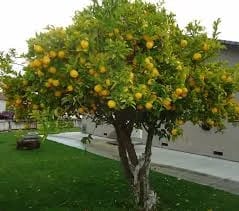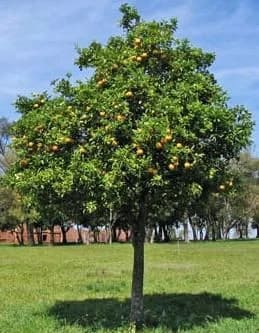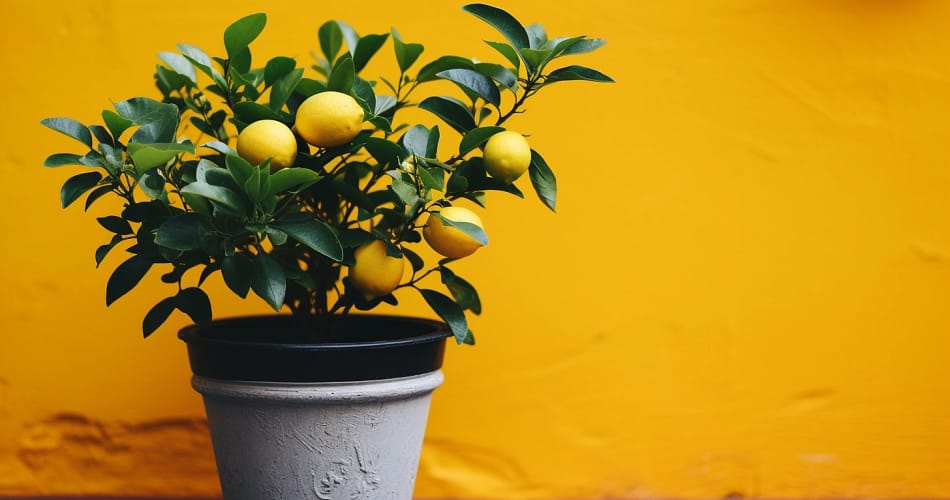The lemon tree (Citrus limon) is a small evergreen tree prized for its bright yellow fruits and fragrant blossoms. Native to Asia, it belongs to the Rutaceae family and is cultivated worldwide for both culinary and ornamental purposes. Lemon trees typically grow up to 10-20 feet tall, with glossy green leaves that emit a refreshing citrus aroma when crushed. The tree bears oblong or elliptical yellow fruits known as lemons, which are rich in vitamin C and widely used in cooking, beverages, and household cleaning. For lemon trees to thrive, they need a sunny spot, soil that drains well, and regular watering.They are often grown in gardens, orchards, and pots, providing both aesthetic beauty and practical use in culinary arts and home remedies.
Lemon Tree Plant: Country-wise Information
United States
- Regions: Lemon trees thrive in USDA hardiness zones 9-11, suitable for warm climates such as California, Arizona, Texas, and Florida.
- Varieties: Popular varieties include Eureka, Lisbon, and Meyer lemon, each with distinct flavor profiles and growth habits.
- Cultivation: Lemon trees thrive in full sun, well-drained soil, and benefit from frost protection. They are commonly cultivated in gardens, orchards, and as container plants.
- Harvest: Fruits ripen from winter to summer, depending on the variety.
Italy
- Regions: Lemon cultivation is prominent in Southern Italy, particularly along the Amalfi Coast and Sicily.
- Varieties: The Amalfi lemon (Sfusato Amalfitano) is celebrated for its aromatic flavor and delicate skin, making it ideal for producing limoncello.
- Cultivation: Grown on terraced hillsides known as “lemon gardens” (giardini di limoni) due to the steep terrain.
- Harvest: Typically harvested from February to October, with peak production during spring and early summer.
Spain
- Regions: Lemon trees are cultivated in regions like Valencia, Murcia, and Andalusia.
- Varieties: Primofiori and Verna are common lemon varieties grown for their juiciness and high yield.
- Cultivation: Requires well-drained soil and irrigation due to the Mediterranean climate. Often grown alongside oranges and other citrus fruits.
- Harvest: Main harvesting period from January to April, with a smaller harvest in summer.
India
- Regions: Major lemon-producing states include Maharashtra, Andhra Pradesh, Gujarat, and Tamil Nadu.
- Varieties: Indian varieties include Nagpur, Kaghzi, and Eureka, each adapted to local climatic conditions.
- Cultivation: Grown in diverse agro-climatic zones, from tropical to subtropical regions. Irrigation is crucial during dry spells.
- Harvest: Year-round production with peaks during summer and monsoon seasons.
Australia
- Regions: Lemon trees thrive in temperate regions of Queensland, New South Wales, Victoria, and South Australia.
- Varieties: Common varieties include Lisbon and Eureka, suitable for both home gardens and commercial orchards.
- Cultivation: Requires well-drained soil, regular watering, and protection from frost. Grown in backyard gardens, orchards, and pots.
- Harvest: Typically harvested from winter to summer, depending on local climate conditions.
Brazil
- Regions: Lemon trees are cultivated in states like São Paulo, Minas Gerais, and Rio de Janeiro.
- Varieties: Tahiti lime (limão Taiti) is a popular variety known for its acidity and juiciness, used in culinary and beverage industries.
- Cultivation: Grown in subtropical regions with adequate rainfall and well-drained soil. Often intercropped with other fruits and vegetables.
- Harvest: Main harvest from April to September, with continuous production throughout the year.
Each country offers unique insights into lemon tree cultivation, reflecting local climates, varieties, and agricultural practices tailored to maximize fruit quality and yield.

How to Plant Lemon Trees at Home: Country-wise Guide
United States
- Planting: Choose a sunny location with well-drained soil. Plant in USDA hardiness zones 9-11.
- Care: Water deeply but infrequently, and fertilize regularly with citrus-specific fertilizer.
- Pruning: Prune to shape the tree and improve air circulation.
- Harvest: Fruits ripen from winter to summer.
Common Diseases and Solutions:
- Citrus Canker: Identified by lesions on leaves and fruit. Solution: Remove infected parts and use copper-based fungicides.
- Root Rot: Caused by waterlogged soil. Solution: Improve drainage and avoid overwatering.
Italy
- Planting: Cultivate in well-drained, slightly acidic soil in sunny spots, often seen in Southern Italy.
- Care: Ensure consistent watering and fertilization throughout the growing season.
- Pruning: Trim to uphold its form and eliminate any dead branches.
- Harvest: Main harvest from February to October.
Common Diseases and Solutions:
- Mediterranean Fruit Fly: Attacks fruit. Solution: Use traps and insecticides.
- Anthracnose: Fungal disease causing fruit rot. Solution: Apply fungicides and improve air circulation.
India
- Planting: Plant in well-drained soil with pH 5.5-6.5. Suitable for tropical and subtropical climates.
- Care: Irrigate regularly, especially during dry periods. Fertilize with organic matter.
- Pruning: Prune to improve airflow and remove diseased branches.
- Harvest: Year-round, with peak seasons in summer and monsoon.
Common Diseases and Solutions:
- Citrus Wilt: Causes yellowing and wilting of leaves. Solution: Improve drainage and use disease-resistant varieties.
- Citrus Leaf Miner: Larvae tunnel through leaves. Solution: Use sticky traps and beneficial insects.
Australia
- Planting: Grow in well-drained soil with full sun exposure. Suitable for temperate regions.
- Care: Water deeply but infrequently. Fertilize with balanced citrus fertilizer.
- Pruning: Prune after fruiting to maintain shape and stimulate new growth.
- Harvest: Winter to summer, depending on climate.
Common Diseases and Solutions:
- Brown Rot: Fungal disease causing fruit decay. Solution: Remove infected fruit and apply fungicides.
- Scale Insects: Sucking pests on leaves and stems. Solution: Use horticultural oil and natural predators.
Brazil
- Planting: Plant in fertile, well-drained soil with full sun exposure. Suitable for subtropical regions.
- Care: Provide regular irrigation and fertilize with nitrogen-rich fertilizer.
- Pruning: Prune to remove dead wood and shape the tree.
- Harvest: Main harvest from April to September, with continuous production.
Common Diseases and Solutions:
- Greasy Spot: Fungal disease causing oily spots on leaves. Solution: Apply fungicides and improve airflow.
- Phytophthora Root Rot: Causes root decay. Solution: Improve drainage and avoid overwatering.

Conclusion
Growing lemon trees at home can be rewarding, providing fresh fruits and enhancing garden aesthetics. By following country-specific planting guidelines, proper care practices, and addressing common diseases promptly, you can successfully cultivate healthy lemon trees in diverse climates and regions.
Certainly! Here are some frequently asked questions (FAQs) about lemon trees:
- How often should I water my lemon tree?
- Lemon trees thrive with soil that is consistently moist but not waterlogged. Water deeply when the top inch of soil becomes dry, particularly in hot weather.
- When and how (fertilize my lemon tree)?
- Fertilize your lemon tree with a balanced fertilizer formulated for citrus trees in spring and summer. Remember package instructions for the proper amount.
- What kind of sunlight does a lemon tree need?
- Lemon trees thrive in full sunlight. Plant require at least 7-8 hours of direct sunlight daily to produce healthy fruit.
- To safeguard your lemon tree from pests and diseases?
- Monitor for common issues such as aphids, scale insects, and spider mites. Employ organic solutions like insecticidal soap or neem oil when necessary. Maintain good air circulation and avoid overwatering to prevent diseases.
- When is the best time to harvest lemons?
- Lemons are typically harvested when they reach full color and size, usually in winter or early spring, depending on the variety. Lemons should be firm and fully colored.
- Can lemon trees grow indoors?
- Yes, they can be grown indoors in containers. Choose a dwarf variety suitable for container growing and place it in a sunny spot. Ensure good drainage and needed water.
- How long does it typically take for a lemon tree to start producing fruit?
- Lemon trees generally start producing fruit within 3 to 5 years after planting, depending on the growing conditions and variety.
- Should I prune my lemon tree?
- Yes, pruning helps maintain the shape of the tree, promotes air circulation, and removes dead or diseased branches. Prune during late winter or early spring, prior to the onset of new growth.
- What are some common lemon tree varieties?
- Some popular lemon tree varieties include ‘Eureka’, ‘Lisbon’, ‘Meyer’, and ‘Ponderosa’. ‘Meyer’ lemon is especially popular for its sweeter flavor and smaller size.
- How do I transplant a lemon tree?
- Transplant lemon trees carefully during their dormant season (usually late winter or early spring). Choose a well-draining location with full sun, dig a hole twice as wide as the root ball, and gently place the tree in the hole, filling it with soil up to the root collar.
These FAQs should help you get started and care for your lemon tree successfully!

